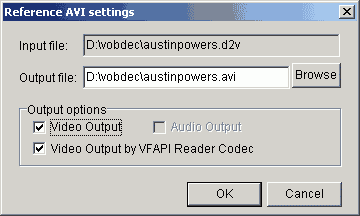VFAPI Reader Codec
This nice little software by the author of TMPEGEnc allows you to create a kind of pseudo AVI of various file types, among them TMPG's project files, AviUtl project files and DVD2AVIs project files.
A brief explanation on how this works: VFAPI acts like a regular video compression codec except that it isn't a codec, but more like a wrapper. A brief explanation on how it works: VFAPI gets uncompressed RGB data from the serving application (DVD2AVI, AviUtl or TMPG) and wraps it into an AVI so that the file can be opened in any application which supports the AVI format.
Let's illustrate this further when using DVD2AVI. Once you've converted a dvd2avi project and loaded this into an AVI reading application it's like you've loaded a regular AVI file. Now let's say the application wants to read frame 1000 of the AVI. What happens is that VFAPI tells the VFP plugin (dvd2avi.vfp) that frame 1000 is required. DVD2AVI will then decode frame 1000 of the VOB file and serve this frame via its VFP plugin in uncompressed format to VFAPI. VFAPI will then wrap the frame to AVI format.
The beauty of this approach is that even though you're basically dealing with uncompressed video data which is huge (we're talking hundreds of Gigabytes here) only one frame at a time will be decompressed which is very space-economic. Of course, this is very simplified but basically this is what's going on.
Before you convert, run proxyoff.reg which comes with VirtualDub (it's in your
plugins subdirectory to the directory where you copied VirtualDub into) and
answer yes to the question that will pop up. Before the first use of this tool
also execute vifpset.bat that comes in the VFAPI distribution. This is requires
as VFAPI has to be registered as a video codec to be recognized the by application
on the receiving end.
Now start the VFAPI Reader Codec (VFAPIConv-EN.exe) and press Add Job, then select the source d2v/tpr/aup file.
 Actually this application supports audio.. but the input project must contain an audio track and the audio will be completely written to the pseudo AVI. Choose your output filename, then press OK and after that press Convert. You'll now have a very small AVI file that you can load in any encoding program.
Actually this application supports audio.. but the input project must contain an audio track and the audio will be completely written to the pseudo AVI. Choose your output filename, then press OK and after that press Convert. You'll now have a very small AVI file that you can load in any encoding program.
Before we go on you should check if the file is valid. Load the AVI file into Windows Media Player. If you can see the video (it will be slow, there's nothing to worry about if it's a slideshow rather than a movie) everything is okay and you can go on. If not, verify again that you've run proxyoff.reg. If it still doesn't help get avifile.reg from the software page and double click on it as well (again you'll be prompted if you want to add the info to your registry, answer yes to this). For more troubleshooting information please refer to the readme.txt which comes with VFAPI (you'll have to download from this page.. other sites don't have this file).
>> BACK
 Actually this application supports audio.. but the input project must contain an audio track and the audio will be completely written to the pseudo AVI. Choose your output filename, then press OK and after that press Convert. You'll now have a very small AVI file that you can load in any encoding program.
Actually this application supports audio.. but the input project must contain an audio track and the audio will be completely written to the pseudo AVI. Choose your output filename, then press OK and after that press Convert. You'll now have a very small AVI file that you can load in any encoding program.